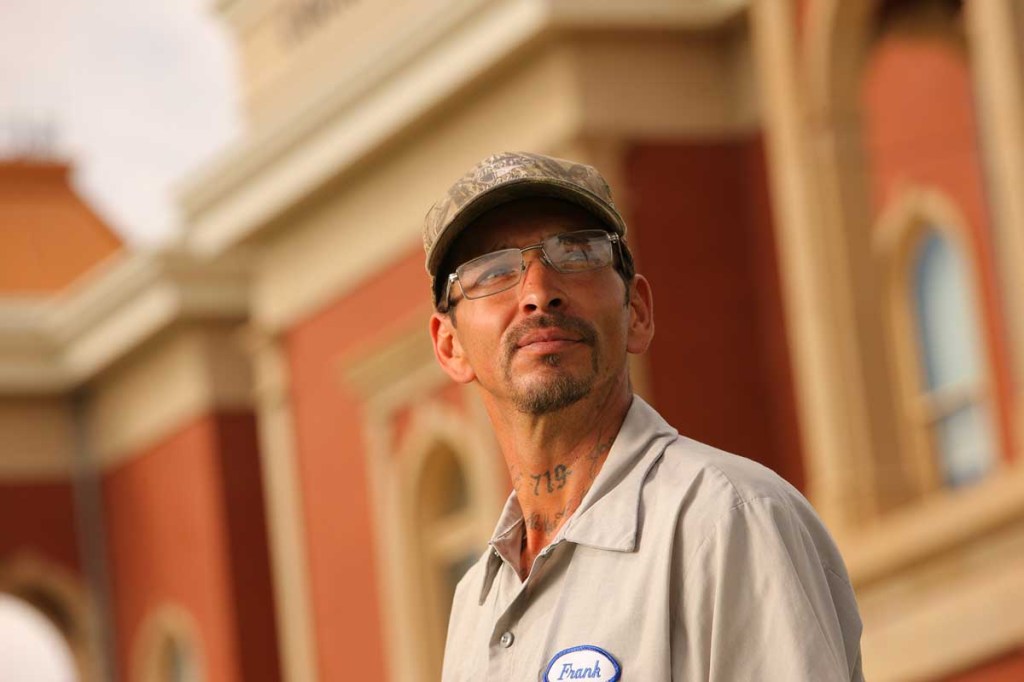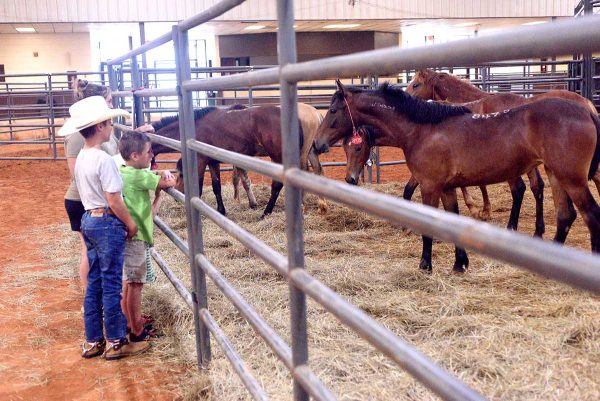Rural poverty: Your fate is increasingly tied to your town
Published 1:48 pm Friday, August 8, 2014

- Frank Martinez, shown at his job as a groundskeeper in Las Animas, Colo., on Aug. 5, managed to turn things around from a life of poverty, but he worries about whether his kids should leave Las Animas, where there are few jobs.
LAS ANIMAS, Colo. — The town of Las Animas takes about five minutes to drive through when the one stoplight is blinking yellow, as usual. It’s easy to miss but hard to escape. Just ask Frank Martinez.
Martinez doesn’t remember having a deprived childhood. His mom was a home care nurse and his dad was disabled from a workplace injury, but he and his five siblings always had what they needed, even if they didn’t wear the latest Nikes to school.
That childhood was cut short, however, when he fathered his first child at 16, married another girl when he was 18, and had three more kids before she left and his grandparents took them in. Meanwhile, with not much honest work around to do, Martinez started stealing and dealing drugs. At one point, he made it two hours away to the post-industrial town of Pueblo, and shacked up with his brother, who was working construction. But with a criminal record and no GED, jobs were scarce, and he retreated to the familiar.
“A person ain’t going to be able to pick up and move to Pueblo broke,” says Martinez, who at 32 is covered with tattoos, including the local area code “719″ across his Adam’s apple. “If you ain’t got your drivers license, if you ain’t got your education, you ain’t got a job, you’re stuck.”
That’s the story of the new rural poverty in America: If your hometown went south, you probably did with it, unless you managed to get out and had the wherewithal to not come back.
The poverty of Las Animas isn’t the poverty of Appalachia or the Mississippi Delta or an Indian reservation, entrenched and intergenerational, enforced by age-old hierarchies of race and class. It’s the kind of poverty that can affect anyone who finds themselves in a place when the native industries disappear, as they have in Southeast Colorado and other rural areas across America.
“It just led to other things,” Martinez says, of the lack of jobs growing up. “Anything just to get money, because there’s nothing here, there’s nothing here. Everyone is on some sort of income here, whether it’s welfare or Social Security, so it’s not like there’s people here who could pay someone to go do their yard.”
For Martinez, life started to turn around when he landed in drug court, which helped him finally get clean. He met Jenny, who also had a few kids and a drinking problem. They both got sober and moved into the ramshackle white house in the center of town that she grew up in. Local officials gave Martinez a job as a groundskeeper at the courthouse, which he took with some trepidation, given that it’s where he used to go to get sentenced. Along with Jenny’s part-time job at Dairy Queen, he figures they make about $30,000 — enough to feed their brood, but not to move much further up the economic ladder.
Martinez doesn’t pretend that his own choices weren’t to blame for his tours through prison and rehab. And now, things have stabilized; he goes to work every day in a gray uniform with his name embroidered on the breast, and has his own office in the basement with a desk. But in a place with more opportunity, or at least more capital, his chances would have been a whole lot better.
“I think it’s more of a place-based poverty than it is demographic,” says Tracey Farrigan, an economist with the U.S. Department of Agriculture who is studying how rural poverty has spread. “People are moving to areas where they can afford to live, which are areas with less support for them. It’s kind of a cycle. So the places are poor, and the people are poor.”
– – –
Las Animas, the seat of Bent County, has the bones of a larger city. And it wasn’t always poor.
Well, it was relatively poor, in the way that rural places long have been — people don’t necessarily make that much money, but the cost of living isn’t that high either. About a decade ago, though, the town’s prospects took a turn for the worse.
The surrounding land, once covered with vegetable fields, had been steadily shedding farming jobs as tractor tines replaced human hands. Around 2000, it started to lose its lifeblood: Weakened by low commodity prices and drought, farmers sold their water rights to speculators and the state’s thirsty cities, whose populations just kept growing. The sugar beet factory closed in the 1980s, along with other processing facilities; agricultural consolidation meant small farmers would have to drive hours to sell their livestock and crops.
Other employment centers quickly followed suit. In 2001, the century-old Fort Lyon Veterans Administration Hospital seven miles away shut down, and hundreds of well-paid medical jobs disappeared. A bus factory a few miles to the east of Las Animas and a pickle factory to the west went dark in 2005. In 2011, the state closed the prison that it had started on the hospital grounds, and last year replaced it with a program for homeless addicts that employs a fraction of the staff.
As the area’s jobs dried up, Las Animas’ main street evaporated with it, leaving empty windows along its stretch of Highway 50 (though the opening of a Walmart 20 miles away in La Junta didn’t help). There were once three grocery stores, and now there’s just Thaxton’s. There were four Mexican restaurants; now there’s just Carmen’s. There’s an Amtrak station, but the train doesn’t stop there anymore. There was a video store, but it closed soon after a Redbox showed up at one of the gas stations. A few weeks after that, Redbox pulled out too.
What’s left: A sleepy nursing home, a private prison that’s an hour’s drive away, a hog farm that’s been having problems with disease, and the various social service agencies that dispense aid to people who need it, which is almost everyone. The shrinkage has some stark numbers associated with it: Las Animas had 3,253 people at its peak in 1998, and has since lost nearly a third of its population. This year’s graduating class of seniors was at an all-time low of 23 kids, down from about 100 in 1975. The poverty rate increased from 20.4 percent in 2000 to 31.7 percent in 2012. The percentage of males in the workforce sank by 25 percent, to about half that national average.
Bill Long, a Bent County commissioner, owns Las Animas’ most successful business: A Dairy Queen, which has enjoyed 20 years of growth, and bustles with burgeoning families every evening. It’s the town’s only chain restaurant, and Long says Las Animas couldn’t support another one (which doesn’t stop townies from whispering that he kiboshed a Pizza Hut to keep out the competition). Other economic development projects haven’t panned out: Ideas for a power plant, a dairy, even just a “food hub” for farmers to sell their produce have hatched and died.
“We’re not going to get a Volkswagen plant in southeastern Colorado,” says Long, referring to the fight over whether the German automaker would add a factory in Tennessee, which has infrastructure like a major highway, and less distance to a port. “What do we do to bring new opportunities? I honestly couldn’t tell you.”
Those who do have jobs, or connections to people with jobs, often stay in spite of themselves. Frank Schmeiser, 32, grew up working for his parents’ construction company. They moved to Arizona after the projects stopped coming, and he moved around for a while working on wind farms. But in 2008, he came back to live with his girlfriend, who works at the prison. He wound up on the city council after nobody ran for a seat; the $200 monthly salary pays his rent, and he’s decided to stick around for a while to see where it goes.
“You could ask ten people what they think of the area, and nine of them would say they can’t stand it, but they never leave,” says Schmeiser, sitting outside at the Dairy Queen on an overcast evening, as baseball teams disgorge from buses and run inside. “It seems like a lot of people are just beaten down, almost depressive. We could get jobs, and jobs that we wanted, pretty easily elsewhere. We stay here because we’re insane, I guess.”
Insane, maybe. But also, people get comfortable. To learn why, belly up to the bar on a Friday night at the Mooseknuckle, one of the town’s two watering holes. A giant moose head presides over the shrieks of a bachelorette party, which a few wallflowers watch with vacant stares from side tables. Everyone knows one another, especially the blonde bartender, who checks in on her patrons with the sympathetic familiarity of someone who’s heard their problems more than once.
Carlos Alvidiez and Joe Frazier, a prison guard and a maintenance worker at Fort Lyon, are winding down from the week with giant steins of pale beer, a rubbery-looking pizza lying neglected on the bar. Frazier grew up in nearby Rocky Ford, and Alvidiez came to the area as a child with his family, who moved away from the declining cotton industry in Texas to work in the vegetable fields of the Arkansas Valley. Neither of them loves his job, and recreation’s sparse too — the decade-long drought decimated the John Martin Reservoir, which at one time was the best way to spend a Saturday afternoon.
“It used to be,” Alvidiez says. “Now, drinking is.”
Most of their kids have already left town, for good reason.
“I’m just as guilty as the next,” says Frazier, a big guy in a Green Bay t-shirt. “I encouraged them — get out of here. There’s nothing here.” He helped coach the high school football team, even as it was downgraded from 12 players a side to 8, with the pool of available recruits rapidly shrinking.
Frazier might leave town when his youngest son graduates, but only if his wife wins the argument. So far, he’s siding with Alvidiez, who isn’t sure he’ll ever leave.
“Here’s the crazy thing,” Alvidiez says. “I’ve had the opportunity to leave this damn town, and I won’t. I like the people.”


